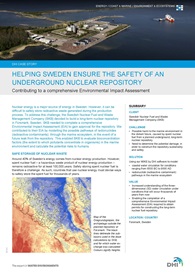Ensure the safety of an underground long-term repository for spent nuclear fuel in Sweden
We’re helping the Swedish Nuclear Fuel and Waste Management Company (SKB) gain approval for a long-term repository for spent nuclear fuel. Around 40% of Sweden’s energy comes from nuclear energy production.
 We’re helping the Swedish Nuclear Fuel and Waste Management Company (SKB) gain approval for a long-term repository for spent nuclear fuel.
We’re helping the Swedish Nuclear Fuel and Waste Management Company (SKB) gain approval for a long-term repository for spent nuclear fuel.
Around 40% of Sweden’s energy comes from nuclear energy production. The spent nuclear fuel – a hazardous waste product of nuclear energy production – remains radioactive for at least 100,000 years. To store it safely, SKB planned on constructing an underground long-term repository near Forsmark, Sweden.
To gain approval for the repository, SKB needed to complete a comprehensive Environmental Impact Assessment (EIA). As part of the EIA, it was necessary to determine:
- dose loads – the amount of radionuclides the environment (and subsequently humans) could be exposed to if a leak occurred
- how a release of spent nuclear fuel to the coastal waters would spread through the marine environment of the nearby Baltic Sea
This would enable SKB to evaluate bioconcentration factors (the extent to which pollutants concentrate in organisms) in the marine environment and calculate the potential risks to humans.
In order to complete the EIA, SKB asked us to model the circulation of the water around the coastal archipelago off Forsmark under different future conditions. We also developed a model of the pathways of radionuclides through the ecosystem, which could be used for comparison with other modelling efforts.
All of our work was subject to a very strict quality assurance system. As part of that system, we submitted the modelling results to an external review panel of experts. They were later published as part of the very comprehensive EIA carried out by SKB. Using our results, SKB could:
- evaluate previously determined bioconcentration factors
- feed their own dose models for calculating the risks to humans – for example, from eating fish caught in the archipelago
Read more